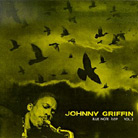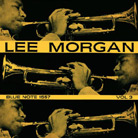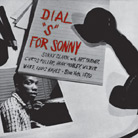![[SoundStage!]](../sslogo3.gif) The Vinyl Word The Vinyl WordBack Issue Article |
July 2005 Found On Vinyl: Johnny Griffin, Lee Morgan, and Sonny Clark Have you priced original Blue Note jazz LPs lately? They’re selling for hundreds and, in some rare cases, thousands of dollars. For a single used LP! I don’t know about you, but that puts them well out of my reach. At such prices, even The Donald would think twice before cracking open his wallet. The trouble is, the originals sound terrific. So what’s a poor analog-loving audiophile to do? Buy the CD? Come on. Settle for the later re-pressings by Liberty or United Artists, the quality of which is markedly inferior to that of the originals? No way. Then there are the more popular titles that were re-pressed in the mid 1980s using the Direct Metal Mastering process. Those are so bright as to be almost unlistenable. Fortunately, Michael Hobson of Classic Records had the same concerns. His answer was to license as many titles from Blue Note as he could and reissue them on virgin 200-gram vinyl. Hobson’s ongoing Blue Note reissue series is a jazz-lovers dream come true. Using the new Quiex SV-P vinyl formula, Classic Records has already reissued many older Blue Note titles, and more are available each month. At $33 a pop, they would seem to be a screaming bargain, but that only holds true if they compare favorably in terms of sonics. Let's find out.
With only four tracks on this album, you know that there’ll be enough space for each musician to stretch out as far as he wants and develop every theme and phrase to its logical conclusion. You can, thanks to the impressively low noise floor of the Quiex SV-P vinyl formula, hear well down into the mix. A good playback system will extract every nuance and follow each player as he runs through his lines. That also makes it mighty easy to hear the differences among of the tenors. Griffin’s hard-edged, hard-blowing, muscular style contrasts nicely with Coltrane’s more abstract, fully thought-out permutations and Mobley’s smoother, more melodic lines. Morgan’s trumpet is portrayed with a full measure of brassy bite. Blakey is at his propulsive best. Kelly’s comping -- he doesn’t solo much at all -- is perfectly suited to the material. Chambers’s bass is full and deep, though not quite as tight as one might wish. All in all, the sum total makes for an extremely enjoyable listen.
This album marks the debut of the Golson original, and soon to be jazz standard, "I Remember Clifford," which was dedicated to the late Clifford Brown, who died the year before. Golson "worked with this melody for three weeks, trying to get a melody that would be reminiscent of him and the way he played." He also demonstrated real foresight in using this number here. After all, who better to play this tribute to Brownie than Lee Morgan? His playing on this album and the others from the same year would mark him as the greatest trumpet star to emerge immediately following Brown’s passing. Morgan’s tone is clearly reproduced. All the proper spittiness, blat, and burnished warmth are there for your ears to devour. Both Golson’s tenor and Gryce’s alto have that bent-brass-instrument sound together with the noise their fingers make on the keys. Persip’s drums, Chamber’s bass, and Kelly’s piano, while not as clearly recorded -- perhaps due to their strict supporting role on this album -- are all still easily followed. Once again, Classic’s attention to detail in the mastering process pays huge dividends. And since we’re talking about recordings made almost 50 years ago, that’s saying quite a bit as to the high quality of Blue Note owner Alfred Lion’s and engineer Rudy Van Gelder’s efforts.
Dial "S" For Sonny is chock-full of Clark’s own compositions -- he was an excellent composer as well as pianist. Some of Clark’s compositions have become part of the standard jazz repertoire -- all you John Zorn fans, think "News For Lulu," for instance. This album gives the listener a very nice intro to Clark’s easy, fluid, loping style, which lent itself equally well to leading or backing others. Based on the quality of the musicianship displayed here, one could have expected a stampede of jazz lovers for copies. Sadly, that wasn’t the case. This is one of the rarer (in decent condition, that is) Blue Note titles, so Classic’s reissue is especially appreciated. One of the fun aspects of listening to this record is contrasting it with the previous two. The piano style of Clark compared to that of Wynton Kelly is as instructive as it is enjoyable. So too is the sound of Farmer’s trumpet versus that of Morgan’s, and especially the bass playing of Ware and Chambers. Thanks in no small part to the quietness of Classic’s vinyl formula, every slight nuance, every dip and dart of Clark’s fingers as they glide over the keyboard, is there for you to examine. Such resolution makes for one heck of a good time. Given the ever-escalating prices of clean, quality original Blue Note LPs, Classic’s reissues shout "bargain!" in a big way. Not only do these albums stand well enough on their own merits, they easily withstand comparison to the original issues. Classic has done a fabulous job of reproducing everything from the covers to the labels to the deep groove under the label (a much-sought-after feature that marked first pressings of early Blue Notes). Each LP was as flat as a pool table, as quiet as church, and as meticulously reproduced as anyone could wish for. Taken together with the knowledge that you hold in your hands a new album that is sonically the equal of the original, at a price that even the most close-fisted can afford, you’ll be feeling pretty darn good for having the foresight to buy new and not used. As with Classic’s RCA Living Stereo series of a few years back, this Blue Note series is a very welcome development. A job well done -- but let us hope not nearly finished. ...John Crossett |
|
![[SoundStage!]](../sslogo3.gif) All Contents All ContentsCopyright © 2005 SoundStage! All Rights Reserved |
 I’ll open
the proceedings by talking about Johnny Griffin’s A Blowing Session
[Classic/Blue Note 1559], recorded in 1957 with Griffin, John Coltrane and Hank Mobley on
tenor saxes; Lee Morgan on trumpet; and an all-star rhythm section of Wynton Kelly on
piano, Paul Chambers on bass, and Art Blakey on drums. This album wasn’t a
cutting-edge session in the typical sense of the phrase, but more a friendly game of
horse, with each musician attempting to keep up with the others.
I’ll open
the proceedings by talking about Johnny Griffin’s A Blowing Session
[Classic/Blue Note 1559], recorded in 1957 with Griffin, John Coltrane and Hank Mobley on
tenor saxes; Lee Morgan on trumpet; and an all-star rhythm section of Wynton Kelly on
piano, Paul Chambers on bass, and Art Blakey on drums. This album wasn’t a
cutting-edge session in the typical sense of the phrase, but more a friendly game of
horse, with each musician attempting to keep up with the others. Next up is Lee
Morgan’s Vol. 3 [Classic/Blue Note 1557], also recorded in 1957. Morgan’s
trumpet is in exalted company, joined by Gigi Gryce on alto sax, Benny Golson -- who wrote
and arranged all the numbers here -- on tenor sax, Wynton Kelly on piano, Paul Chambers on
bass, and Charlie Persip on drums. Listening to this album, one would never know that
Morgan was a mere lad of 18 and working the tail end of a string of three albums released
within that single year. While availing himself once again of Golson’s assistance,
Morgan nonetheless marks this as his album. Each of the five numbers on this LP are
full to bursting with Morgan’s most creative playing, and his band mates take their
cues from him, matching him note for note.
Next up is Lee
Morgan’s Vol. 3 [Classic/Blue Note 1557], also recorded in 1957. Morgan’s
trumpet is in exalted company, joined by Gigi Gryce on alto sax, Benny Golson -- who wrote
and arranged all the numbers here -- on tenor sax, Wynton Kelly on piano, Paul Chambers on
bass, and Charlie Persip on drums. Listening to this album, one would never know that
Morgan was a mere lad of 18 and working the tail end of a string of three albums released
within that single year. While availing himself once again of Golson’s assistance,
Morgan nonetheless marks this as his album. Each of the five numbers on this LP are
full to bursting with Morgan’s most creative playing, and his band mates take their
cues from him, matching him note for note. Finally, I come
to the third album of this survey, also from 1957, an exceptional year in jazz (and for my
parents): Sonny Clark’s Dial "S" For Sonny [Classic/Blue Note 1570].
Clark never received quite the public attention his work merited before he passed away in
1963 at the far-too-young age of 31. He was widely admired by his fellow musicians, as can
be noted from the number of recording sessions in which he took part. Here, in his debut
on Blue Note, Clark on piano is showcased with a group of his peers. (This was something
Alfred Lion was most ingenious at setting up, which may help to explain why Blue Note LPs
are so highly prized today.) Together with Art Farmer on trumpet, Curtis Fuller on
trombone, Hank Mobley on tenor sax, Wilbur Ware on bass, and Louis Hayes on drums, Clark
demos his underrated abilities in ideal conditions.
Finally, I come
to the third album of this survey, also from 1957, an exceptional year in jazz (and for my
parents): Sonny Clark’s Dial "S" For Sonny [Classic/Blue Note 1570].
Clark never received quite the public attention his work merited before he passed away in
1963 at the far-too-young age of 31. He was widely admired by his fellow musicians, as can
be noted from the number of recording sessions in which he took part. Here, in his debut
on Blue Note, Clark on piano is showcased with a group of his peers. (This was something
Alfred Lion was most ingenious at setting up, which may help to explain why Blue Note LPs
are so highly prized today.) Together with Art Farmer on trumpet, Curtis Fuller on
trombone, Hank Mobley on tenor sax, Wilbur Ware on bass, and Louis Hayes on drums, Clark
demos his underrated abilities in ideal conditions.